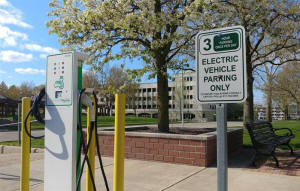New report shows Illinois job, economic growth in electric
transportation sector
 Send a link to a friend
Send a link to a friend
[April 15, 2021]
By GRACE BARBIC
Capitol News Illinois
gbarbic@capitolnewsillinois.com
 SPRINGFIELD – A national clean energy trade
organization has released a report showing growth in electric
transportation-related jobs in Illinois could position the state to lead
the domestic supply chain. SPRINGFIELD – A national clean energy trade
organization has released a report showing growth in electric
transportation-related jobs in Illinois could position the state to lead
the domestic supply chain.
Advanced Energy Economy, an industry association which promotes advanced
energy technologies and services, released its “Electrifying Illinois”
report which shows the state is on pace to reach 83 percent job growth
in electric transportation-related work by 2024, regardless of
legislative action.
The report was funded by the AEE and prepared by the research group BW
Research Partnership with a focus on examining economic and job
opportunities as the automotive industry transitions to electric.
The anticipated growth would drive the workforce numbers up from the
current 5,200 workers in Illinois to roughly 9,500 workers within the
next three years, or less than three years, according to the study,
which used multiple data collection methods to analyze the state’s
electric vehicle supply chain.
Daniel Bloom, who leads legislative campaigns across the Midwest for AEE,
said this projected growth is a “conservative estimate.”

“This (report) is really looking at the opportunity for Illinois, but
from the regional perspective,” Bloom said. “We don't see a reason why
Illinois can't become a new Detroit.”
There were roughly 27,000 total electric vehicles registered in Illinois
as of March 2021, Bloom said. AEE recommends the state reach 1.2 million
electric vehicles by 2030, but “policymakers can accelerate this
transition by taking the right steps in legislation this spring,” Bloom
said.
The report outlines a number of policy recommendations, many of which
align with Gov. JB Pritzker's eight principles for a clean and renewable
Illinois economy, which were released in August. AEE was a part of a
working group for the governor’s office in the fall.
Some of AEE’s recommendations include establishing a tax credit for
electric vehicle companies that relocate to Illinois or are located
downstate, and initiating a regulatory process to emphasize building out
“make-ready” charging infrastructure.
A “make-ready” is a parking space that is wired with electrical
infrastructure to support electric vehicle charging that can be placed
at multi-family dwellings, the workplace or other public interest sites.
Transportation accounted for about 28.2 percent of greenhouse gas
emissions in the United States in 2018, according to the Environmental
Protection Agency, making it the largest contributor of U.S. greenhouse
gas emissions.
Some energy proposals currently being discussed in the General Assembly
set goals for electric vehicle developments in Illinois because of the
public health and environmental impacts of the traditional
transportation industry.
The Clean Energy Jobs Act, sponsored by Rep. Ann Williams, D-Chicago,
would aim to transition public transportation to an electric fleet,
create an initiative to incentivize electric vehicle charging and create
a program to ensure access to electric vehicles, among other efforts.
The stated goal is to electrify the state’s transportation sector by
2030.

Several other measures are being considered as well, from a union-backed
bill to one backed by downstate energy provider Ameren, to another “coal
to solar” transition measure. All have come before committees in recent
weeks as lawmakers consider a broader regulatory reform package that
could include facets from all of the proposals.
Illinois Clean Air Now, a coalition of clean energy, health advocacy and
transportation stakeholders, is urging the General Assembly to include
comprehensive transportation electrification legislation as part of the
overhaul package.
[to top of second column]
|

An electric vehicle charging station is pictured
outside of the Illinois State Capitol Complex in Springfield.
(Capitol News Illinois photo by Jerry Nowicki)

In a news release distributed by the coalition, Brian Urbaszewski,
director of environmental health at the Respiratory Health
Association, said Illinois has a historic chance to clean the air,
improve quality of life and reduce health care burdens by passing
electrification legislation.
“Transportation policies focused on eliminating harmful tailpipe
emissions, like the ones under consideration here, can significantly
reduce deadly air pollution,” Urbaszewski said of discussion of
energy bills in the General Assembly.
Illinois Clean Air Now said that prioritizing electrification
efforts would also have economic benefits. The release cited two
projections that conclude Illinois electric vehicle adoption “could
result in cumulative net benefits that range from $12 to $45 billion
statewide by 2050,” according to the release.
Electronic transportation activity in Illinois, according to the
“Electrifying Illinois” report, contributed $850 million to Gross
State Product based on data from the 2019 United States Energy
Employment Report, which was produced by the National Association of
State Energy Officials and the Energy Futures Institute.
“With investments that we're seeing in the state from companies like
Rivian, we hope that this is a signal to encourage additional
private investment in the state of Illinois and make us a global
leader in not just meeting the demand that we have locally in the
state or regionally, but because of the globalized nature of this
supply chain, being able to meet that with work that's done in
Illinois is really critical,” Bloom said.
Through data collection, the analysis found that Illinois has 560
electric-transportation related businesses in 97 of its 102
counties. The state already has a significant motor vehicle
manufacturing presence, with 3,400 workers, or two-thirds of those
employed in electric transportation, working in manufacturing.
About 70,000 workers in manufacturing industries that are currently
not directly involved with the electric transportation businesses,
but have characteristics similar to companies that are, would
require “relatively little training” to transition to this type of
work, the report found. Examples of these types of businesses
include general automobile manufacturing, specialty transformer
manufacturing, or machine shops, to name a few.

“It's not just companies that have built up as servicing only the
electric vehicle supply chain, but it's also companies that have had
operations across a various number of sectors that are starting to
build this into their operational capacity,” Bloom said. “So that's
fascinating as we look at emerging opportunities across the whole
supply chain.”
Training programs in electric transportation services could
potentially “offer a lifeline to those (manufacturing industries),
which shed 15,900 jobs across the state between 2014 and 2019,”
according to the report.
As demand for electric vehicles increases, so does the demand for
charging infrastructure.
Bloom emphasized that expanding necessary training programs in the
state is essential to continued growth in the industry, which is why
AEE recommends broadening geographic reach and availability of the
Electric Vehicle Infrastructure Training Program.
That program already exists in some areas in Illinois. But AEE said
that by partnering with junior colleges, trade schools and labor
organizations, “the state can create a steady pipeline to develop
its EV workforce.”
The Biden administration has also set the stage for the
electrification conversation through its investments in electric
vehicle infrastructure. The White House recently released its
American Jobs Plan, which is a $2.3 trillion infrastructure proposal
that includes $174 billion for the electric vehicle market.
Capitol News Illinois is a nonprofit, nonpartisan
news service covering state government and distributed to more than
400 newspapers statewide. It is funded primarily by the Illinois
Press Foundation and the Robert R. McCormick Foundation. |